You can make this delicious marinara sauce recipe inspired by Boston's Italian restaurants and our fantastic farmers markets in just 10 minutes.
Use tomatoes straight off the vine from your own garden, Boston's Haymarket, or whatever farmers' market is near you, although canned tomatoes also work well.
Serve your tasty pasta with marinara sauce as a main entrée or side dish.
If you've dined in Boston Italian restaurants, you probably know that great marinara sauce is at the heart of many wonderful dishes.
Each chef takes pride in his or her own special version, and once you dine in even just a couple of the North End's Italian restaurants, you'll start to notice the subtle differences.
You can customize this basic marinara sauce recipe by adding your favorite herbs and other seasonings to create your own signature flavors. Your family and friends will beg you to make this homemade tomato sauce again and again.
And in late summer, when your garden or your favorite farmer's market overflows with juicy ripe tomatoes, there is no better recipe for making a tasty meal tonight - and freezing the leftover sauce for a cold night next winter.
Top Photo: Vine ripened home-grown tomatoes in Boston Discovery Guide's test kitchen, (c) Boston Discovery Guide
Boston Discovery Guide is a reader-supported publication. When you buy through our links, we may earn a commission at no additional cost for you. Learn more
Pasta with Fresh Tomato Marinara Sauce Recipe
Prep time: 5 minutes
Cooking time: 8 - 10 minutes
Serves: 4 - 6 as a main course, or 8 - 10 as a side dish
This recipe assumes that you're serving the sauce over pasta, but you could also use the sauce in other dishes such as Eggplant Parmesan or even on homemade pizza.
Fresh tomato marinara sauce also freezes well. You can easily double or triple the recipe, especially since there's no set amount of salt - just add a quantity that tastes good to you.
Ingredients for marinara sauce
- 1 pound (16 ounces) pasta - any shape is fine . . . linguine, spaghetti, rotini, rigatoni. Use your favorite brand - a good quality imported Italian pasta, supermarket brands such as Barilla, even fresh pasta
- 2 tablespoons olive oil (we use full-flavored Greek, Italian, or Spanish first cold pressed olive oil from local markets and stores, Trader Joe's extra virgin cold pressed Italian olive oil, or Costco's Kirkland brand organic extra virgin olive oil)
- 6 - 8 fresh ripe tomatoes
- 4 cloves garlic (or more if you like)
- 1 tablespoon balsamic vinegar
- Salt
- A dash of cayenne
- Optional: About 3 - 4 tablespoons pesto (you can buy or make this - for a quick homemade version, see our totally easy basil pesto recipe). Alternately, use fresh or dried herbs such as basil and oregano - start with a little and add more until you get the flavor intensity that you prefer.
- For serving - also optional: About 3-4 ounces aged Italian cheese such as Parmesan, Romano, or asiago
Steps for making fresh marinara sauce recipe
1. Boil water - Bring a large pot of water to a boil. You can add a spoonful of salt to the water if you want.
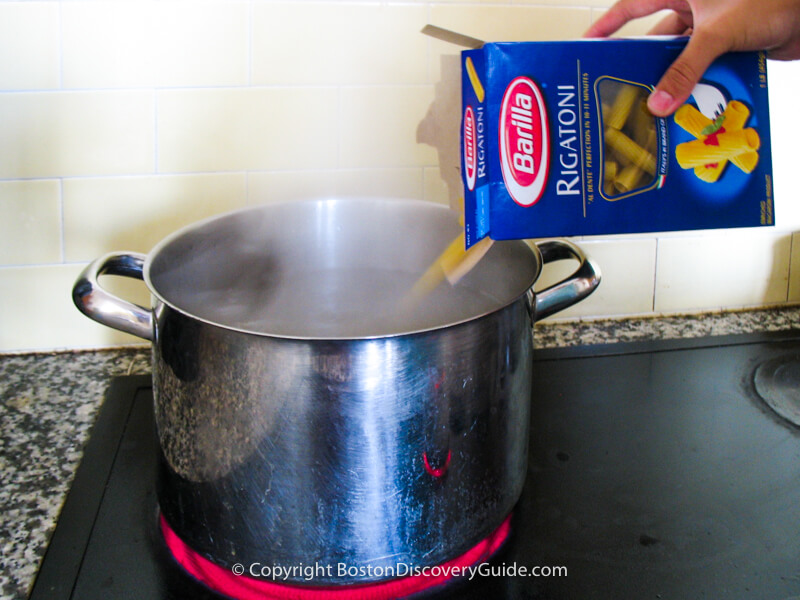
Pour in the pasta, and cook until al dente - in other words, the pasta should still be a little chewy, and not soft or mushy. (This assumes that you're using dried pasta, which will take maybe 10 minutes to cook once you add it to the water. If you're using fresh pasta, that normally cooks in 2-3 minutes, so wait until your sauce is finished to prepare it.)
2. Prep ingredients - As soon as you start heating the water for cooking the pasta, get the main ingredients ready. Thinly slice or chop the garlic cloves. Trim the tomatoes to remove the stem ends if necessary and chop them coarsely into fairly large chunks.
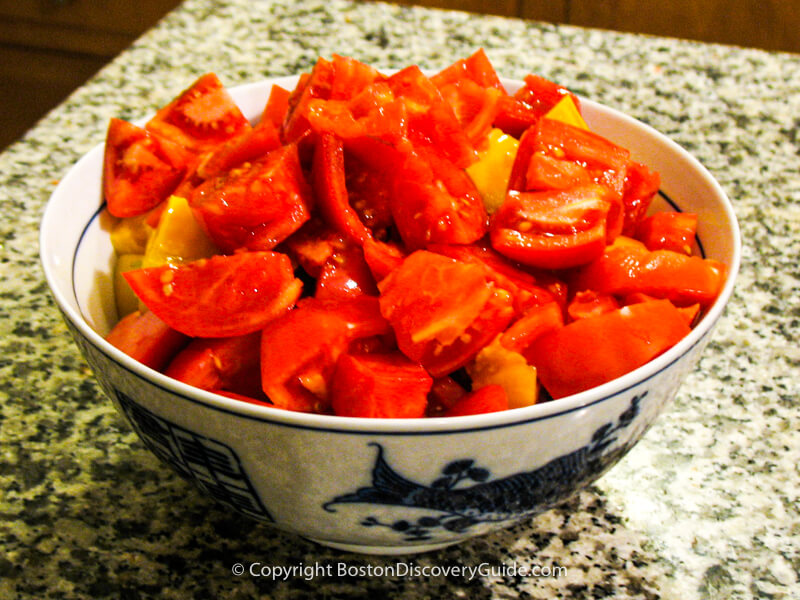
3. Start cooking - Pour the olive oil into a large stainless steel saute pan or sauce pan with at least 3-quart capacity, and place on medium heat. No need to measure - just pour in about 2 tablespoons. If you use a little more or a little less, it doesn't matter. Wait about 30 seconds, and then add the tomato chunks.
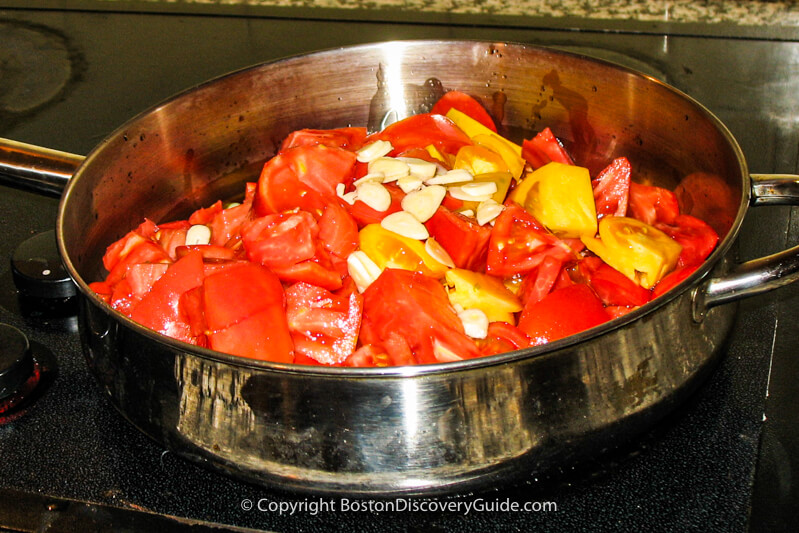
After another minute or so, when the tomatoes begin to sizzle and release their juices, add the garlic. Waiting until this point prevents the garlic from turning brown or burning, which causes a bitter flavor - this way, it stays sweet.
Please note: Never use aluminum pots when cooking tomatoes - aluminum is reactive with the acid tomatoes, which will make the tomatoes taste weird; the acid will also create pits in the aluminum's surface. We use an All-Clad 3-quart stainless steel saute pan (which you can see in the photo) which works really well, but any stainless steel saute or sauce pan will work fine.
4. Cook - Let the tomatoes and garlic cook for about 5 - 10 minutes, stirring occasionally, until the tomatoes get soft and the sauce begins to thicken.
The exact amount of time will vary depending on how much heat you're using, the juiciness and texture of the tomatoes, and your own preferences about whether you want the sauce to be chunky or smoother.
If you want to use fresh basil pesto in your sauce and don't have any made, make it now - takes about 1 minute. Here's our super-easy and foolproof basil pesto recipe.
5. Grate cheese - While the sauce is cooking, grate the cheese.
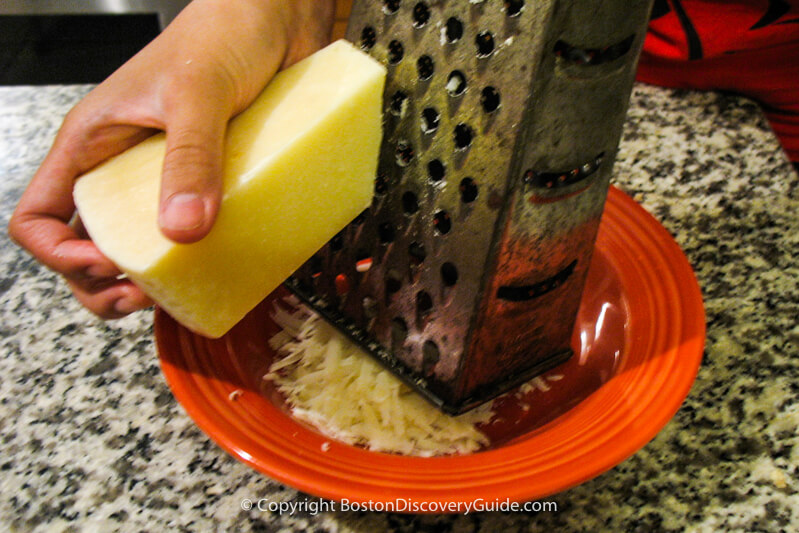
6. Add vinegar - When the marinara sauce reaches the texture you prefer, add the balsamic vinegar, and let the sauce cook for another 30 - 60 seconds until the vinegar's strong smell goes away.
7. Season - Lower the heat. Add a dash of cayenne to taste. Stir, and remove from heat.
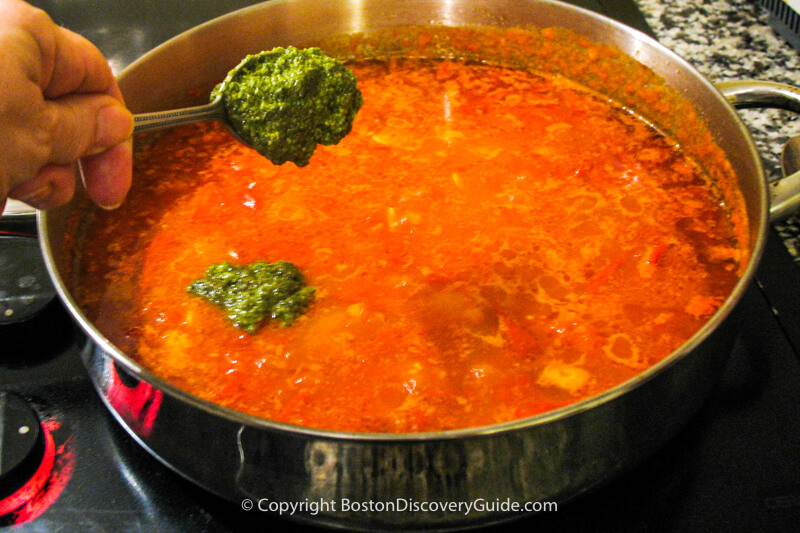
Optional enhancements: Now, if you want, add pesto or herbs to make the flavor more complex. If you're adding pesto, add about 2-3 rounded spoons filled with it and stir to blend. Taste - and add more if you want a stronger taste. If you're using fresh or dried herbs, add anywhere from a little to a lot, depending on your preference. Taste again, and add a bit of salt to enhance the flavor if you'd like.
That's it!
Drain the pasta in a colander. Put the pasta and sauce into a large serving bowl, and mix well.
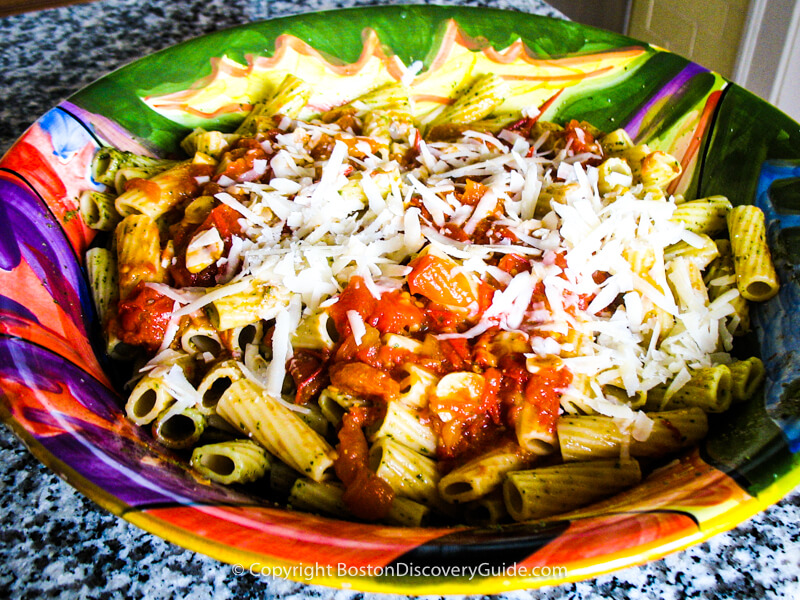
Sprinkle the grated cheese on top, or serve separately on the side.
This is our favorite marinara sauce recipe, and definitely the easiest. Serve with crusty French or Italian bread, a green salad, and a mellow red Italian wine. And of course, if you have some tiramisu on hand, that's the perfect way to finish your meal.
Want to know Boston Discovery Guide's secret tip for smooth sauce?
As you may have noticed, we didn't make any attempt to peel the tomatoes, scoop out the tomato seeds, or to chop the garlic into the tiniest bits possible. This means that your sauce will have the slightly lumpy texture that's typical of marinara sauce.
But here's the secret: if you want a sauce with an absolutely smooth silky texture achieved by some of Boston's top Italian restaurants and served with meatballs or eggplant Parmesan, you can create that from this sauce.
We don't actually know how chefs achieve their satin-smooth sauce - but here's how we achieve it, and you can too: Double or triple the amount of tomatoes called for in this recipe, and cook them long enough so that a lot of the liquid has evaporated - maybe an hour - and the flavor becomes rich and intense. Let your sauce cool a bit, and then puree it in a blender for about 30 seconds. That's it: no more seeds, skins, or other texture - just silky smooth sauce. Pour it back into the pot and reheat to the desired serving temperature.
Marinara Sauce Recipe Variations - 4 Easy Ideas
- To make this marinara sauce recipe with canned tomatoes, use a 28 ounce (1 pound, 12 oz) can of whole (you can also use pureed if you want a very smooth sauce) instead of the fresh tomatoes. San Marzano tomatoes work well - you can usually find several brands in the store. Canned tomatoes can be slightly more acidic than fresh tomatoes so you may want to add 1/2 - 1 teaspoon of white or brown sugar, or even a little honey. Also, canned tomatoes usually contain salt, so add more salt sparingly, if at all.
- Add chopped, pitted kalamata olives for a Mediterranean twist. If yours still have their pits, put the olives on a cutting board and slightly smash them with something flat and heavy, like the bottom of a teacup or the flat slide of a Chinese cleaver blade. The pits will pop right out.
- If you like the sauce with olives, you may also want to add some tuna packed in olive oil, such as Genova brand - add the olive oil along with the tuna. Leftover grilled fresh tuna also works.
- Buy and grill some good quality sausages - sweet or hot. Or make some meatballs. Serve with the marinara sauce and pasta.
What Can You Do with Marinara Sauce Leftovers?
Make marinara sauce recipe in late August and early September, when Haymarket and farmers' markets around Boston overflow with juicy, ripe tomatoes for sale at very attractive prices.
The marinara sauce freezes well, so you can make lots and enjoy the leftovers all winter for a delicious taste of Boston summer at its best.
Fun Boston Food Tours for You to Experience!
More Articles about Cooking & Dining in Boston
Need a Boston Hotel or Apartment?
Use this handy map from Booking.com to find the perfect place to stay. Just enter your dates to find what's available, see the best rates, and make your reservations.
Booking.com
































